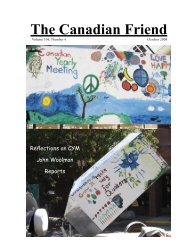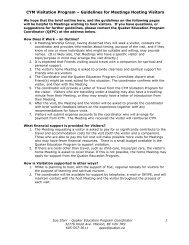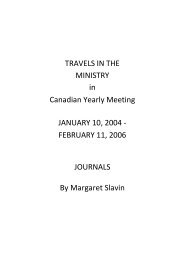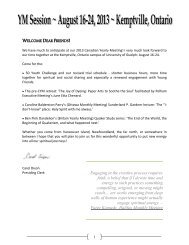Download pdf - Canadian Yearly Meeting
Download pdf - Canadian Yearly Meeting
Download pdf - Canadian Yearly Meeting
Create successful ePaper yourself
Turn your PDF publications into a flip-book with our unique Google optimized e-Paper software.
The difference became clear to me while reading TheFirst Paul by Marcus Borg and Dominic Crossan. Theypointed out that the phrase, ‘the faith in Jesus Christ’,which occurs often in Paul’s Epistles, is definitely anerror of translation. Greek grammar clearly indicatesthat it must be rendered as ‘the faith of Jesus Christ’,which means something very different. It leads fromcrying out to God, “Why hast thou forsaken me?”to, “Into thy hands I commit my spirit”, and shifts usfrom ‘fear’ to ‘trust’.Faith as trust is not the same as certainty; it isnever absolute. Faith as trust includes an element ofdoubt. The two are in constant tension, a bit like thepull of gravity that makes the roots of a plant growdown while the stalk reaches up for the light.Those who had fear instilled in them from an earlyage or those who were confronted by suffering beyondendurance may find security in the content of a specificfaith, with its accompanying picture of reality. Beingconfronted with a different picture or viewpoint canbe frightening. If their viewpoint is the only one theycan rely on, their fear may turn into aggression andviolence at worst, to deep suspicion at best. We canobserve this all around us.In fact, some of the fiercest conflicts can bebetween those who share traditions, such as haveprevailed between Sunni and Shiite Muslims. In thepast, Christianity became mired in multiple internalconflicts. Usually such conflicts were not so muchabout the content of different faiths as they were aboutwhich one would dominate. The power of a trustinglove that underlies faith is defeated by the love ofpower over faith.It is almost impossible to avoid painting a faithpicture of some kind to complement an eclipsedtrust, when our foothold seems to loosen and thedim window on reality turns dark. As long as thepicture does not obscure the window of faith and itsoutlines are not too definite, our eye will be able todiscern when the light behind that window returns.With the Light, we can plant our feet firmly in faithagain, and consciously let go of our viewpoint. We nolonger need to cling to it. I wonder whether that iswhat Jesus meant when, in the book of John, he saysto Mary, “Do not cling to me. I have not yet ascendedto the Father”. Ascending to the Father, to me meansbeing absorbed into the ‘ocean of Light and Love’ thatGeorge Fox wrote of.We are often oblivious to the Light because it can’tbe seen except through the eyes of faith. With these eyeswe can look at other faiths without feeling threatenedby them – even if they have led to untruth, injusticeand suffering. Such ‘fruits’ have to be countered withthe ‘fruits of the Spirit’, not with hostility.During my further explorations through thedictionaries I discovered that trust, troth and truth wereclosely linked, through the words for trustworthinessand faithfulness in Dutch and German, as well asthe word for ‘protectively held’ in Norwegian. Onedictionary suggests that in the remote past, in veryOld English, the root ‘tr’ was the same as we find in‘tree’.I was reminded of being shown a tree in Hiroshima,which had been blasted and seemingly permanentlyblighted by the atom bomb. Yet, after many years, ithad started to sprout again. I also saw a tree in Hollandthat was known to have been growing in a certain spotin the seventeenth century. It was apparently a deadstump, which recently began to put out new shootsafter the rotten and diseased parts were removed. Thesight of both of these trees moved me deeply. If treescan do that, ‘trust’, ‘troth’ and ‘truth’ can surely alsoregenerate when the hand of love is applied.Ellen PyeVancouver Monthly <strong>Meeting</strong>Volume 109, Number 2 21








